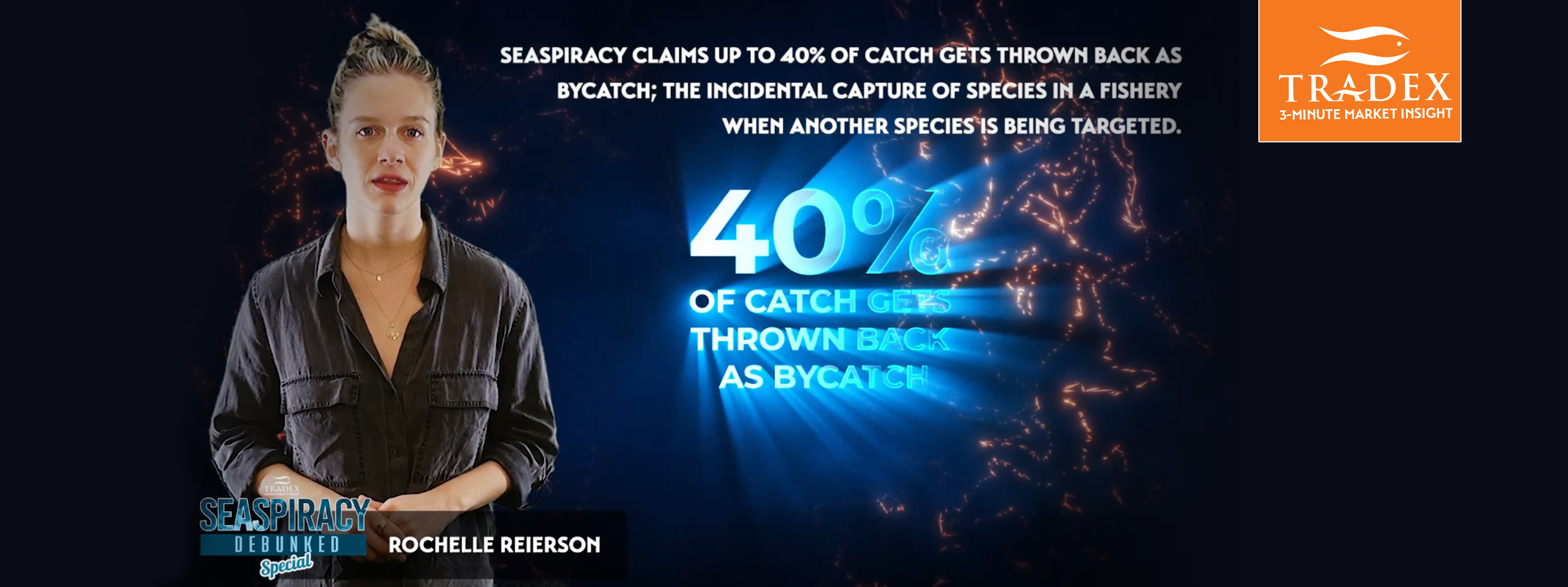
Loading
EP 566 | AIRED 11/29/2021
Seaspiracy Debunked: Exposing a Film of Misinformation and Myths
November 29th, 2021 --- This week, we take a look at the most controversial documentary of the year, Seaspiracy, and debunk some of the highlighted accusations. Join us as we take a deeper dive into what is indeed fact, and what is fiction.
--- It has been seven months now since Netflix’s “Seaspiracy” cast it’s line and hooked millions of viewers around the world; a documentary on the damage that industrial fisheries inflict on the oceans and humans.
Within days, the film created seismic waves and controversial discussions.
For some, this groundbreaking documentary left people wondering things like what the year 2048 would look like with fishless oceans.
For others, this grossly misinformed film left viewers with a fishy taste in their mouths.
It was a film of misinformation and misinterpretation that led Emily De Sousa, a fisheries scientist and travel & food writer, to take it upon herself to expose the truth.
Emily’s article on, The science of Seaspiracy, breaks down nine myths Seaspiracy had served its viewers over a course of 90 minutes, and instead explains the science of sustainable seafood.
Emily De Sousa: “As soon as I saw certain things like the 2048 statistic, I knew that’s wrong, I knew how to refute that very quickly.”

De Sousa is referring to the documentary's first myth which repurposes the already over-repeated claim “oceans will run out of fish by 2048”.
Before you quickly change your diet to vegetarian like Seaspiracy recommends you to do, De Sousa assures us this couldn’t be further from the truth. De Sousa states “monitored fish populations (representing over half of the world’s catch) are, on average, increasing in abundance and have been for years.”
So where does a statistic like that first get its credibility?
It originates from a 2006 paper that misconstrued a finding in its press release, despite the mistake being corrected by the authors.
To date, research has actually shown that monitored fish populations around the world, representing over half of all catch, are generally healthy or increasing.
If you weren’t already caught up in the tangled net of a potentially fishless ocean, you may have been unintentionally entangled by the next piece of misinformation.
Seaspiracy claims up to 40% of catch gets thrown back as bycatch; the incidental capture of species in a fishery when another species is being targeted.

The truth is 10% has been discarded at sea over the past decade.
Emily De Sousa: "The way that it was portrayed in the film makes it look like some intentional thing or thing that nobody cares about, something that everybody accepts - like we’re just going to catch things and throw them back in the ocean, and that’s just not the case at all. Unfortunately bycatch is a part of fishing but there’s been so much research and technology and innovation to address bycatch, things like turtle exclusion devices and what not to try and limit those numbers, and again, the 40% is not accurate of the fish that’s actually discarded back into the ocean, that number is way way lower, close to 10%."
Sustainable Fisheries UW which De Sousa is associated with explains in a previously published article, people working for NGO’s argued the definition of bycatch needed to include all catch from unmanaged fisheries.
In their words, “unmanaged” is a catch that “does not have specific management to ensure the take is sustainable.”
From what information was drawn from an outdated study, it would seem to indicate that the paper would account bycatch for way more than what is typically accounted for.
What De Sousa contests is “no serious scientist or organization counts unmanaged catch as bycatch—it is a ridiculous thing to conflate. Discards are what matters—10% is the more informative number to cite.”
Tying into the bycatch misconception is Seaspiracy's next claim that 250,000 sea turtles are killed as a result of bycatch in the U.S. every year when in fact, it is estimated that 4,600 sea turtles are killed each year in the U.S.
Though of course sea turtles death due to fishing is something we would hope to avoid altogether, a recent study shows that total death by fishing is actually down 94%.
This has been improved from the help of turtle excluder devices and other modern-day bycatch reducing technology that exists today.
The film continues on to attempt at tackling one of the world's most environmentally impacting issues- plastic.
Seaspiracy reports 46% of plastic in the ocean is from fishing nets.
A statistic which upon further investigation was actually taken from a paper that was published on plastic pollution in the Great Pacific Garbage Patch and not the entire ocean.
Emily De Sousa: "It was found that 46% of the plastic in that great pacific garbage does come from fishing nets but that is not representative of the entire ocean. So it was untrue and really mis-leading, and a lot of science around plastic in the ocean has shown that a lot of the plastic we see in the ocean actually comes from land and this movie is basically trying to claim that almost half of the plastic in the ocean comes from fishing nets and that simply not true."
As stated by De Sousa, BY WEIGHT, 46% of plastic in the Great Pacific Garbage Patch (GPGP) was estimated to be from fishing nets.

Advertise Here: advertising@tradexfoods.com
This means, Seaspiracy only analyzed buoyant plastics which would of course lead to the conclusion fishing nets are the most problematic in the GPGP.
Another poorly misinformative statistic that potentially does more harm than good, misguiding people within their own organizations on what is true and what is fiction in environmental restoration.
What begins as a journey to explore the transient beauty of our oceans, continues on as an ambush on the fishing industry.
Seaspiracy claims fisheries observers and boat captains are corrupt and often lie about how much fish is caught.
The truth is, lying about catch data is highly illegal and results in stripping a fisherman’s license.
Though it would be ignorant to believe relationships between observers and captains have not led to questionable, sometimes deadly, outcomes, fishermen do stick within their catch amount when enforcement is present.
Therefore, it is rare there would be a chance for them to skew the numbers.
It was not long until Seaspiracy came after The Marine Stewardship Council (MSC), saying the certification is too easy to obtain and not credible while adding there is no such thing as sustainability.
In fact, MSC certifications are carried out by third-party auditors using publicly available sustainability criteria.
These certifications are created and used to help consumers make educated purchases and assist in making sustainable options easy to choose.
Emily De Sousa: "Ecolabels and certifications like Ocean Wise, MSC, Seafood Watch are really great tools, especially for the average consumer - like we said, there’s just so much information out there to try and make sense of and it can be super frustrating. So I think ecolabels can be a really effective tool, they’re quick, they’re really simple for consumers to identify with."

Though DeSousa believes such organizations can always do better with addressing social factors in fisheries and seafood, as well as addressing financial barriers that prevent small scale fisheries from accessing eco labels- she reassures us that they are indeed credible in the way the film makes them out not to be.
Emily De Sousa: "In terms of ecological sustainability and certifying sustainable fisheries I think they are effective at that. My issues more so lie with the social side and the small-scale fisheries but I think they are an effective tool for the average consumer to identify a good seafood choice."
To continue on the bamboozling brigade, the film claims 1 in 3 fish imported into the US is caught illegally.
The truth of the matter is this estimate is based on import data from 2011 that has since been significantly corrected, reports De Sousa, with the methodology employed to make the estimate highly controversial.
The documentary briefly shifts their focus to call out Aquaculture, saying it is NOT part of the seafood solution when in fact, "Aquaculture is responsible for over half of seafood consumed globally and is a critical part of achieving global food security for a growing planet" says DeSousa.
As reported in DeSousa's paper, today, aquaculture is the fastest growing food producing sector in the world and is respo nsible for over half of seafood consumed globally. On top of this, approximately 20.5 million people are directly employed by the aquaculture industry..
In a last ditch effort to prove their misguided claims, the film reports there’s no such thing as sustainable fishing or sustainable seafood. Bottom line, fishing is bad and it’s all a conspiracy involving industry, governments, scientists, NGOs, your neighbor.
To put it bluntly from De Sousa- Just stop.
From a film that invites you to believe that sustainable fishing doesn’t exist and to cut out the seafood industry altogether, it was important for researchers like De Sousa to shed light on the truth behind the misinformation.
-- Closing Statement --
Emily De Sousa: "I think a lot of people often forget that fish is part of our food system. Seafood is a really integral part for a lot of diets around the world for a lot of people’s livelihoods around the world. The seafood industry employs hundreds of millions of people worldwide. So this industry is not going away and we can’t afford to have it go away from an economic standpoint, from a human nutrition standpoint. We need seafood, and the solution is not to stop eating seafood, it’s just to eat seafood better."

In the end, the overall goal of De Sousa’s paper hopes to show that you can still eat seafood in a sustainable way and eat seafood AND be an advocate and a champion for the oceans.
In what came into the world like a tidal wave, Seaspiracy quickly loses its credibility within the hurricane of misinformation and fictitious claims.
However, what it does allow for are the ripple effects of real conversations on the importance of sustainable seafood, and the future of the seafood industry as a collective, which hopefully continues to create a wave of discussions and actions for years to come.
As leaders in the seafood industry, we pledge to be a trusted and valued source of accurate information, to provide full transparency of the ever changing industry, and to commit to effective efforts in our sustainability initiatives
--- If you are not already, be sure to subscribe to our 3-Minute Market Insight using the signup form below to keep tuned-in to all upcoming market insights.


